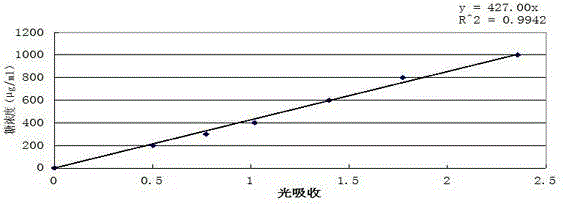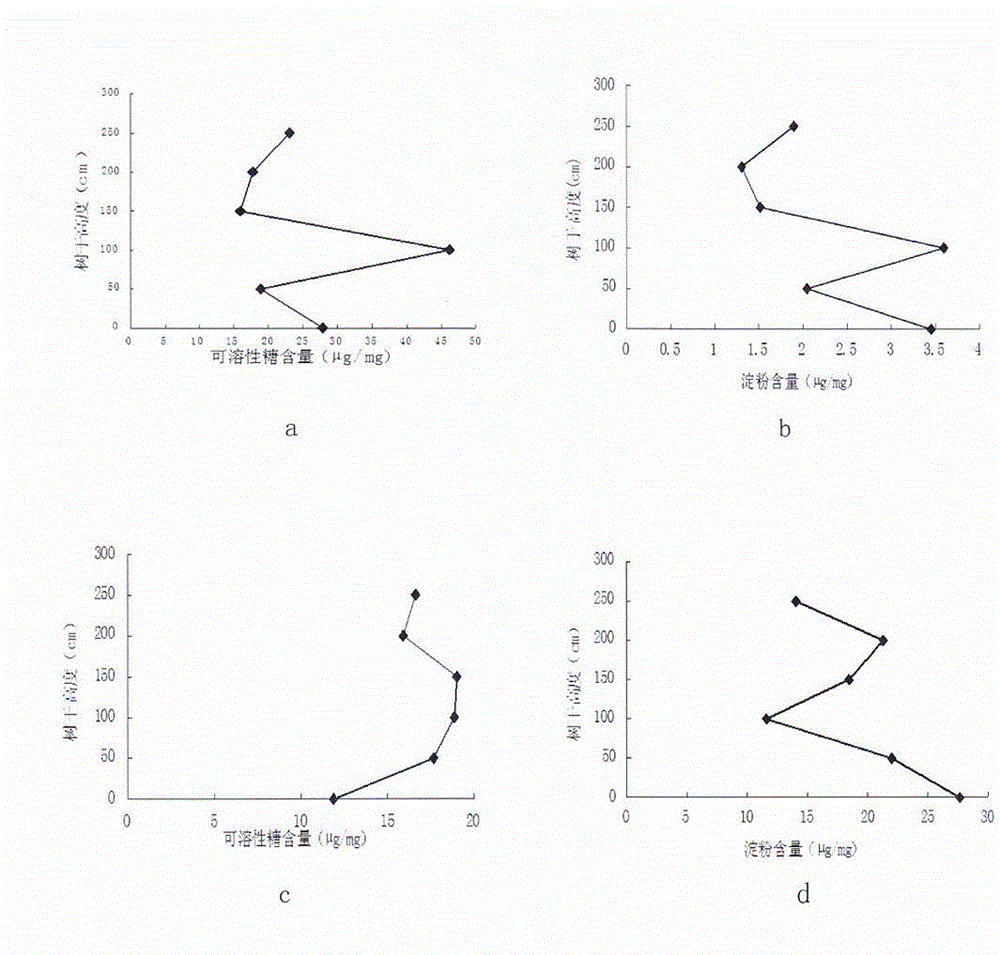Method for measuring content of nonstructural carbohydrates in rubber tree bark and xylem
A carbohydrate and determination method technology, applied in the direction of color/spectral characteristic measurement, etc., can solve the problems of no determination of xylem starch content, no starch content, long time-consuming, etc., to achieve the effect of short time-consuming, simple steps, and little damage
- Summary
- Abstract
- Description
- Claims
- Application Information
AI Technical Summary
Problems solved by technology
Method used
Image
Examples
Embodiment 1
[0033] Establish a standard curve for soluble sugars
[0034] Use 80% ethanol solution to prepare glucose (reducing sugar) and sucrose (non-reducing sugar) solutions with a concentration of 1mg / ml respectively; : 1 volume ratio mixed to form 100μl soluble sugar mixture, 150mg anthrone was dissolved in 100ml dilute sulfuric acid (70ml concentrated sulfuric acid plus 30ml water) to prepare anthrone reagent. Mix sucrose and glucose solution in proportion (the mixing ratio is as shown in the table below), add 3ml of anthrone reagent to 100μl of the mixed solution, keep it warm at 90°C for 15min, and scan the maximum light absorption:
[0035] Table 1 Determination of light absorption peak of soluble sugar
[0036] Sucrose volume (μl) 20 30 50 70 80 Glucose volume (μl) 80 70 50 30 20 Scan the highest absorption peak (nm) 627 626 627 626 626
[0037] It can be seen from the above table that the scanning absorption peak of the light absorption o...
Embodiment 2
[0042] Establish standard curve for starch
[0043] 80%Ca(NO 3 ) 2 Preparation:
[0044] 80gCa(NO 3 ) 2 .2H 2 Dissolve O in water and make up to 100ml.
[0045] I 2 - Preparation of KI solution:
[0046] 1.3gI 2 Add 3.5gKI, and after dissolving, the volumetric flask is set to 100ml.
[0047] The 1mg / ml starch mother liquor was mixed with 80% Ca(NO 3 ) 2 Dilute to 50μg / ml, 100μg / ml, 200μg / ml, 300μg / ml, 400μg / ml starch solution.
[0048] Take 2ml of starch solutions with different concentrations, add 100μl I 2 -KI solution, measure the light absorption at 580nm, draw the standard curve, the curve equation is: y=177.84.00x(r 2 =0.9942) (see figure 2 ).
Embodiment 3
[0050] Obtain bark and xylem soluble sugar extracts and starch extracts from bark and xylem samples, respectively
[0051] a) Sample
[0052] Sampling the rubber tree bark with a small hole puncher with a diameter of 0.5cm, directly poke the hole puncher into the bark by hand, and take out the corresponding bark from the bark as a bark sample; because the rubber tree wood is hard, it cannot be extracted with a sampler Xylem sample, therefore, at the bark sampling port, use a small electric drill to drill a hole in the xylem perforated part to sample wood chips, as a xylem sample, the drilling depth is 3.0cm, and block the bark and xylem sampling port with iron nails of appropriate size after sampling .
[0053] b) Grind the bark and xylem samples with liquid nitrogen respectively, take 10-200mg after oven drying at 40°C, extract with 0.5ml-4ml80% ethanol at 80°C for 40min, mediate and stir in the middle, centrifuge at 12000rpm×10min, collect the supernatant and residue Add 8...
PUM
 Login to View More
Login to View More Abstract
Description
Claims
Application Information
 Login to View More
Login to View More - R&D
- Intellectual Property
- Life Sciences
- Materials
- Tech Scout
- Unparalleled Data Quality
- Higher Quality Content
- 60% Fewer Hallucinations
Browse by: Latest US Patents, China's latest patents, Technical Efficacy Thesaurus, Application Domain, Technology Topic, Popular Technical Reports.
© 2025 PatSnap. All rights reserved.Legal|Privacy policy|Modern Slavery Act Transparency Statement|Sitemap|About US| Contact US: help@patsnap.com



